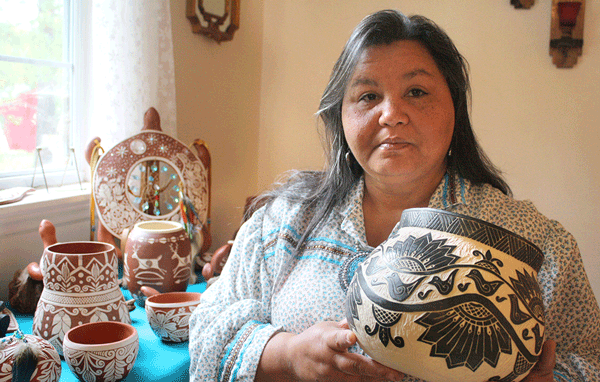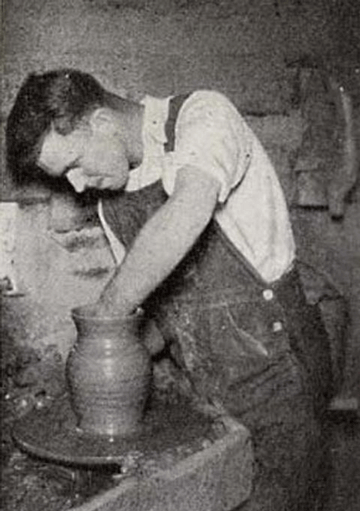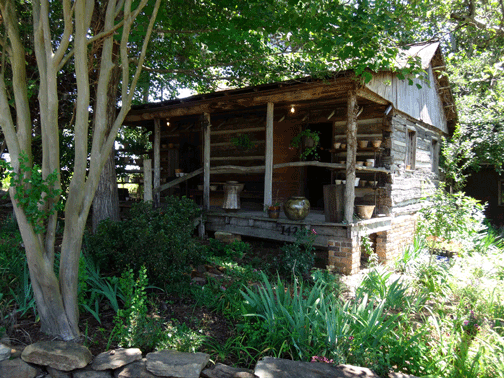Seagrove is a small but mighty artistic town in North Carolina. Officially established in the late 19th to early 20th centuries, Seagrove is now known as the handmade pottery capital of the United States, and holds a rich and extensive history. However, Seagrove’s history is much older than the commonly studied late Europeans to the present day time period. It is not a coincidence Seagrove, North Carolina is the choice home for ceramicists. With a mountain range dating back to the Paleozoic Era and Native people’s working as ceramicists before the European settlers, Seagrove was destined to become a niche environment for potters.
Over 500 million years ago during the Ordovician period within the Paleozoic Era, the Uwharrie mountain range formed in central North Carolina. One of the oldest mountain ranges in the nation’s territory, the Uwharries formed by accretion along the Gondwanan tectonic plate. Rocks that formed during this process are in the igneous category: felsic, rhyolite, and tuffs cover the Uwharrie area. Tuffs, specifically, are large deposits of volcanic ash; over time the tuffs and rocks break down into the soil and the volcanic ash is deposited. The mountain range originally formed along North Carolina’s East coast before moving inland from the Eastern seabed raising. Since the mountain range formed next to the ocean, the volcanic ash deposits formed naturally occurring materials like bentonite which occur in marine areas when pressured between other layers of rock. Bentonite is beneficial to potters because it binds the clay particles together making a denser mass and ultimately a stronger clay. Seagrove’s creek beds and land overall is filled with this dense strong clay. When fired at high temperatures, it becomes what we know as stoneware, a type of ceramic material. Naturally, Seagrove is a perfect place for potters to settle.

Prior to the industrialization of the ceramic industry, raw materials had to be harvested from the land and out of convenience, makers typically settled in the areas rich in material. The Haliwa-Saponi and the Kayauwee are just two of the American Indian tribes that lived in central North Carolina. Prior to the 18th century, potters in the tribes primarily used traditional clay building techniques like coiling, for they had not yet had exposure to the potter’s wheel. Haliwa-Saponi potters would make rounded vessels to use for food and water. Today, Seagrove is not particularly known for native potters; however, there are still very successful Haliwa Saponi potters at work like Senora Lynch.

“The Spirit of clay has always inspired me. Working in clay takes me back to my childhood days of playing in mud, a free spirit” -Senora Lynch
In the late 90s Lynch became a serious potter, using her craft to connect to her heritage and as a tool for teaching. She named her business “Living Traditions”. Her work is decorated with stories of her American Indian heritage. She uses four layers of paint on her coil built pots and then uses a sgraffito technique to carve out illustrative stories. Her work is in permanent collections in the Smithsonian’s National Museum of the American Indians. She has also gained a large amount of respect from North Carolina: her work is featured in the North Carolina Museum of History and she is an artist in residency for North Carolina. She uses her art to teach young minds about the history of American Indian tribes in North Carolina and break down stereotypes. Ceramicists from tribes in the Seagrove area are the first people who established Seagrove, North Carolina as a potter’s home.
In the 1750s, North Carolina began to open up to settlers after the construction of the Great Wagon road. This first wave of Europeans came across Seagrove’s luscious clay beds and settled where they could farm the land and create pottery to sell in their free time. In the early 19th century, Edwin G. Seagrove designed a major train depot that made accessing central North Carolina possible, specifically the area of Seagrove (the town was named after him when the depot was built). He believed in the value of pottery as a source of income so he wanted to be able to bring more potters and customers to the area.
In 1895, the Owen’s family opened the famous “Owens Pottery”; the owners then and now are descendants of Joseph Owen. Owen’s work is the oldest work of the settlers in the state. Shortly after this opening, the couple, Jacques and Julian Busbee discovered Seagrove by tracing a pie plate they adored back to a potter in the area. The Busbees quickly realized the unique atmosphere Seagrove held and decided to stay. In 1917, they opened the famous “Jugtown”. They hired local potters to produce jugs for the whiskey trade. The Busbees were well educated and connected artists; they wanted to ensure everyone knew about the amazing Seagrove. Juliana Busbee went back to New York City and opened up a tearoom in Greenwich village where they displayed Seagrove pottery. Overall, the couple was adamant in upholding Seagrove’s historical connection to ceramics and promoting the local artists. In 1999 Jugtown was listed on the National Register of Historic Places. The Busbee’s promotional work and the local artists’ talent led to Seagrove becoming a national landmark for ceramics.

Today, Seagrove is a community of inspiration and character. Covering 25 miles, with over 85 potters, there is a free exchange of knowledge and accountability. When interviewed for various articles, the Seagrove potters speak about how they are a group of people who are determined to push one another to be better, think bigger, and grow as ceramicists. Although the town is known for its individual potters where each artist has their own special something, each maker still holds a deep respect for the history of Seagrove and ceramic work as a whole. In 2005, Seagrove became the State Birthplace of North Carolina Traditional Pottery.
Ceramics is an art form that has gone through its ups and downs in the U.S. economy. Currently, we are at a high with buyers supporting small business’ and local artists. Daniel Johnston, a Seagrove potter told Artsy.com, “the public is responsible for having kept this going.’ He described the long-standing customers who have collected enough pottery to use handmade dishes during every meal, and remarked that customers ‘are owed a great deal of respect for having maintained that”’. Due to the COVID-19 pandemic, traveling is not recommended; however, for the time being, you can explore Seagrove and its lovely potters online! Discover this niche environment that has sustained potters for thousands of years.

